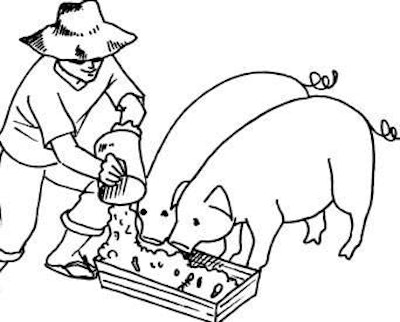
Liquid feeding pigs is a highly sophisticated practice employed today in many progressive operations, especially in Northern Europe, but increasingly in many other parts of the world. It certainly lacks the popularity of the simpler pig dry-feeding methods, mostly because of the greater cost of acquiring a liquid feeding system, but also because of the higher degree of management complexity required for proper use.
The most obvious benefit from liquid feeding pigs is increased feed intake. It has been clearly demonstrated that pigs consume on average 12 percent more dry matter when offered liquid rather than dry diets, with increases up to 33 percent not being uncommon.
The recycling of liquid by-products from the human food industry to feed pigs has the most obvious potential in liquid feeding systems as it offers clear-cut and immediate feed cost savings. Most agro-industrial by-products are rich in carbohydrates, but protein- and fat-rich by-products are not uncommon. The most common six liquid by-products that are safe for pigs include:
1. Cheese whey
Most likely the major dairy by-product throughout the world, it is readily available in most milk-producing areas and it is especially attractive to farmers near cheese factories. It has around 5 percent dry matter, 12-13 percent crude protein (in dry matter), and 60-70 percent lactose (in dry matter).
The salt (sodium) content may be variable and can limit the use of liquid whey as a pig feed ingredient. Due to its low dry matter content, feed intake might be limited in young pigs due to small stomach physical capacity, but growing pigs have no such problems. Diets based on liquid whey seldom require further dilution with water.
2. Liquid wheat starch
A by-product of the extraction of starch and gluten from wheat, it contains about 25 percent dry matter, 50-60 percent sugars and starch (in dry matter), and 10-12 percent crude protein (in dry matter). Excessive intake of sugars may cause secretory diarrhea in young pigs.
3. Potato steam peel
It is the residue from the process of peeling potatoes using pressure and high temperature. It contains about 14 percent dry matter, 13 percent crude protein (in dry matter), and 40-50 percent starch and sugars (in dry matter). Solanine, an anti-nutritional factor in potatoes, might be problematic especially for young pigs.
4. Skim or whole milk
Occasionally, skim or whole milk is offered at competitive prices. These batches are usually expired milk or milk unfit for human consumption. It is suggested that if there is a question regarding its microbiological quality, it is best not to use. Otherwise, milk is an excellent source of nutrients for piglets. Whole milk contains about 12 percent dry matter, 28 percent crude protein (in dry matter) and 40 percent lactose (in dry matter). Skim milk contains about 9-10 percent dry matter, 38 percent crude protein (in dry matter) and 53 percent lactose (in dry matter).
5. Ice cream mix
A fat-rich by-product that is usually a blend of residual ice cream lots and other dairy ingredients. It contains about 28 percent dry matter, 8 percent protein (in dry matter), 20 percent fat (in dry matter) and more than 60 percent lactose (dry matter). Its inclusion level should be determined based on its energy/lipid contribution. It can be of highly variable composition and quality, which necessitates constant monitoring.
6. Semi-moist DDGS
This ingredient is becoming increasingly available as the cost of drying it is usually excessive of its potential benefits. In pig liquid feeding systems, dried-distillers grains with solubles can be an excellent alternative to reduce feed costs. Its moisture content can be variable and does require careful monitoring.
How liquid feeding improves piglet gut health
www.WATTAgNet.com/How_liquid_feeding_improves_piglet_gut_health.html

















